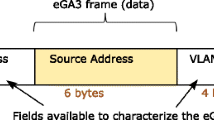Abstract
The success of the Internet is largely ascribable to the packet-switching scheme, which, however, also presents major challenges. Having identified three missing links in the current Internet architecture based on our long-term experiences of designing and operating large-scale backbones, we put forward a new, but incrementally deployable, network scheme—address switching. The address switching has both the advantages of packet switching and circuit switching; it supplies the missing links in the current Internet architecture and can reform the Internet traffic. Our analysis, protocol design and experiments indicate that the address switching can greatly improve the quality of service (QoS), security and routing scalability of today’s Internet. So it can provide flexible, high-performance and “per-service” networking for the scientific research communities. Moreover, it can provide a fairer and more sustainable business model for the commodity Internet.
Similar content being viewed by others
References
Clark D, Wroclawski J, Sollins K, et al. Tussle in cyberspace: defining tomorrow’s Internet. In: SIGCOMM’02, August 19–23, Pittsburgh, PA, USA, 2002
Kuhne M. Plenary Report, IETF68, May 2007, Volume 2, Issue 1
Bernet Y. The complementary roles of RSVP and differentiated services in the full-service QOS network. IEEE Commun Mag, 2000, 38(2): 154–162
Stallings W. Network Security Essentials: Applications and Standards. 3rd ed. Upper Saddle River, NJ: Prentice Hall, Inc., 2007
IETF Homepage: http://www.ietf.org
FIND Project Homepage: http://www.find.org
GENI Homepage: http://www.geni.org
GLIF Homepage: http://www.glif.is
ITU Homepage: http://www.itu.int
CERNET Homepage: http://www.edu.cn/english 1369/index.shtml
Li X, Bao C X. Support for the high-performance video (DVTS) collaboration. In: Spring 2007 Internet2 Member Meeting, http://events.internet2.edu/2007/springmm/sessionDetails.cfm?session=3175&event=267
Comer D E. Internetworking with TCP/IP: Principles, Protocols, and Architecture. Upper Saddle River, NJ: Prentice Hall, Inc., 2006
Shenker S. Fundamental design issues for the future Internet. IEEE J Select Areas Commun, 1995, 13(7): 1176–1188
Gross G. Study: Internet could run out of capacity in two years. IDG News Service 20/11/2007. http://www.macworld.com/news/2007/11/19/internetcapacity/index.php
Bernardo A, Huberman B, Lukose, R M. Social dilemmas and Internet congestion. Science, 1997, 277(5325): 535–537
Williamson C. Internet traffic measurement. IEEE Internet Comput, 2001, 5: 70–74
Blumenthal M S, Clark D D. Rethinking the design of the Internet: the end-to-end arguments vs. the brave new world. ACM Trans Internet Tech (TOIT), 2001, 1(1): 70–109
Ahlgren B, Brunner M, Eggert L, et al. Invariants—A new design methodology for network architectures. In: SIGCOMM’ 04 Workshops, Portland, OR, USA, Aug. 30–Sept. 3, 2004. 65–70
Halabi S, McPerson D. The Definitive BGP Guide, Internet Routing Architecture. 2nd ed. Indianapolis: Cisco Press, 2000
Robert J W. Traffic theory and the Internet. IEEE Commun Mag, 2001, 39(1): 94–99
DVTS system, http://www.sfc.wide.ad.jp/DVTS
TEIN2 Homepage: http://www.tein2.net
Bao C X, Li X, Jiang J P. Scalable application-specific measurement framework for high performance network video. ACM NOSSDAV 2007. http://www.nossdav.org/2007/files/file-29-session5-paper3-bao.pdf
Antonov V. ATM: Another technological mirage or why ATM is not the solution, fat state vs lean state packet switching. http://www.academ.com/nanog/feb1998/parallel/ip vs atm/state.html
Ratnasamy S, Ermolinskiy A, Shenker A. Revisiting IP multicast. In: Proceedings of SIGCOMM’06. New York: ACM, 2006. 15–26
Solomon J D. Mobile IP—The Internet unplugged. In: Prentice Hall Series in Computer Networking and Distributed Systems. Upper Saddle River, NJ: Prentice Hall, Inc., 1998
UCLP Homepage: http://www.uclp.ca
Cohen R. On the establishment of an access VPN in broadband access networks. Commun Mag, 2003, 41(2): 156–163
Crowcroft J. Net neutrality: the technical side of the debate: a white paper. ACM SIGCOMM Comput Commun Review Archive, 2007, 37(1): 49–56
Author information
Authors and Affiliations
Corresponding author
Additional information
Supported by the China Next Generation Internet Project (Grant No. CNGI-04-13-2T), and the National Basic Research Program of China (Grant No. 041710001)
Rights and permissions
About this article
Cite this article
Li, X., Bao, C. Address switching: Reforming the architecture and traffic of Internet. Sci. China Ser. F-Inf. Sci. 52, 1203–1216 (2009). https://doi.org/10.1007/s11432-009-0121-x
Received:
Accepted:
Published:
Issue Date:
DOI: https://doi.org/10.1007/s11432-009-0121-x



